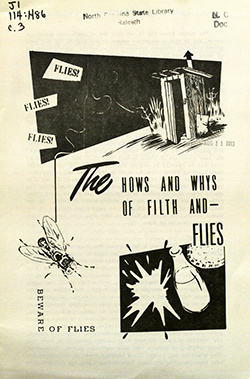Part i: The State Board of Health and Other Early Public Initiatives; Part ii: Expansion of Government Health Agencies and Major Health Issues in the State; Part iii: North Carolina's Modern Health Care System

The Executive Organization Act, passed by the General Assembly in 1971, restructured the North Carolina state government into large departments that included agencies with a related focus. In 1997 the health branch of state government, the Division of Public Health, was placed within the newly named DHHS. Led by the state health director, the Division of Public Health maintains a number of programs and services affecting public health policies in the state.
North Carolina's Area Health Education Centers (AHEC) program was developed in the early 1970s to address the unequal distribution of medical personnel within the state. It trains, recruits, and retains health professionals, thereby serving students, health practitioners, and communities. In 1973 federal money enabled the UNC School of Medicine to open AHEC facilities in Wilmington, Charlotte, and Rocky Mount, and the following year the General Assembly appropriated $24.5 million to build six more centers. Using the state's academic medical centers-UNC-Chapel Hill School of Medicine, Duke University Medical Center, Wake Forest University School of Medicine, and Brody School of Medicine at East Carolina University-as hubs, AHECs developed a regionalized network that links communities in every county in the state to a major hospital or administrative center. All North Carolina medical students complete a clinical rotation in one of the AHEC regions. In 2006 the state's 10 AHECs were located in Asheville, Charlotte, Durham, Fayetteville, Greensboro, Greenville, Raleigh, Rocky Mount, Wilmington, and Winston-Salem.
In the last 30 or more years, public health professionals concentrated on providing education, analyzing vital statistics, and reacting to various health emergencies, such as influenza outbreaks in winter. Immunization of children against diseases also became a major focus. Tuberculosis, though curable, has remained a rare but serious health concern.
A myriad of studies and statistics offer insights into the status of public health in North Carolina in the early 2000s. The state has received praise for its "healthy habits" and "healthy environment." In 2004 a national child health "report card" gave North Carolina high-to-acceptable marks in reducing infant and child mortality and teenage pregnancy, providing necessary immunization, and ensuring adequacy of medical insurance across groups, but the state earned exceedingly low marks in child abuse and neglect, obesity among low-income children, asthma, and the use of alcohol, tobacco, and illegal drugs. In addressing these problems, a task force was appointed to reach future objectives, such as ending disparities between rich and poor North Carolinians and giving further emphasis to preventive services.
The complexity of the state's modern health care system is demonstrated by its many different types of medical facilities, such as acute-care, rehabilitation, and psychiatric hospitals; nursing homes; assisted-living facilities; home health care services; and hospice centers. Administration of health care continues to be a joint responsibility of public agencies at the federal, state, and local levels and private organizations. The DHHS oversees several health-related agencies and state facilities, including the Division of Public Health (encompassing the Departments of Epidemiology, Health Statistics, Women's and Children's Health, and other agencies); the Division of Medical Assistance; the Division of Mental Health, Developmental Disabilities, and Substance Abuse Services; the Division of Aging; and the Office of Research, Demonstrations, and Rural Health Development. The North Carolina Office of the Chief Medical Examiner manages a statewide network of 600 physicians who serve as volunteer investigators in deaths involving unusual circumstances.
Among the private health care organizations are state chapters of national groups, such as the Alzheimer's Association, American Parkinson's Disease Association, Arthritis Foundation, and Alliance of AIDS Societies. Groups founded in the state include the Mental Health Association of North Carolina, North Carolina Dental Society, North Carolina Hospital Association, North Carolina Nurses Association, and North Carolina Psychiatric Association.
Federal Medicare and Medicaid legislation in 1965, and subsequent amendments, ushered in many changes in the health care industry. Medicare assistance for Alzheimer's patients was announced by President George W. Bush in April 2002. By assuming the responsibility of financing health care services for the elderly and the poor, the federal and state governments have become a major force in shaping the way the health care system will continue to operate. The Center for Medicare and Medicaid Services (formerly the Health Care Financing Administration) predicts that government sources will fund about 56 percent of the projected $3.2 trillion in domestic health care expenditures by 2008 as the population continues to age and the baby boom generation enters the Medicare program.